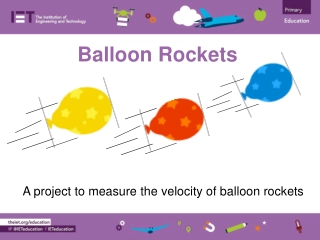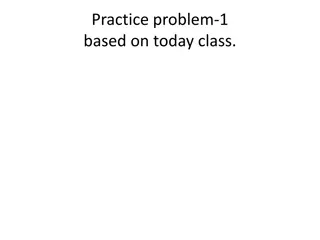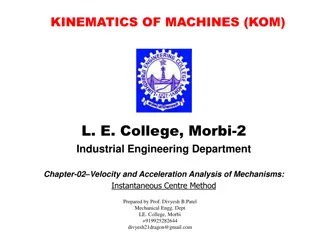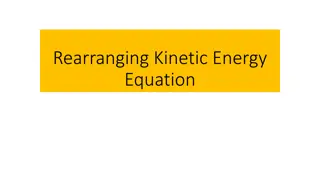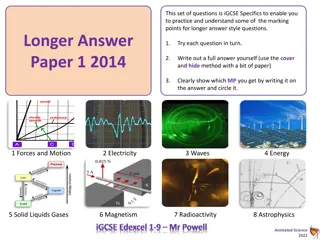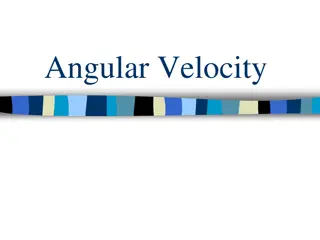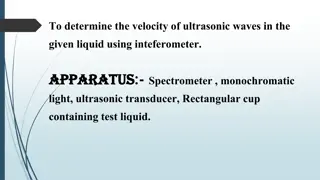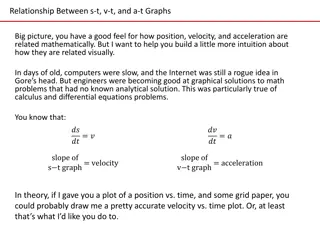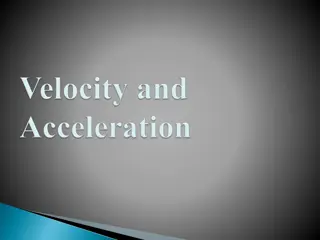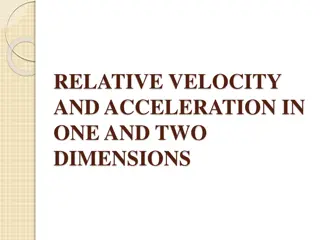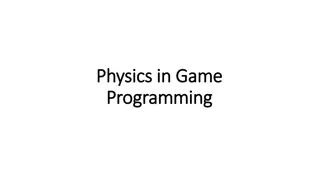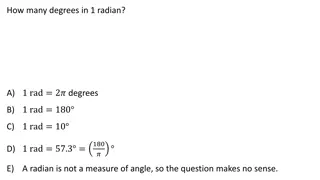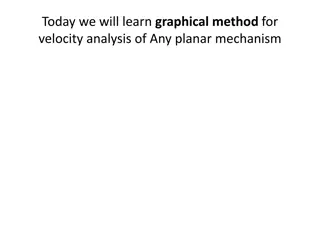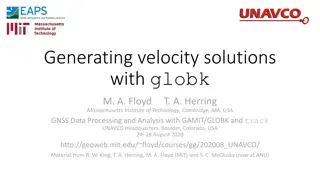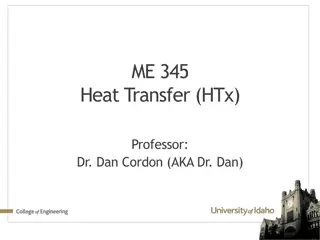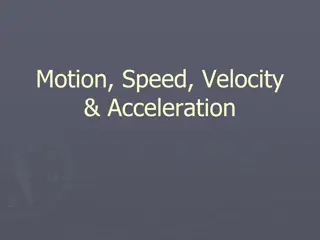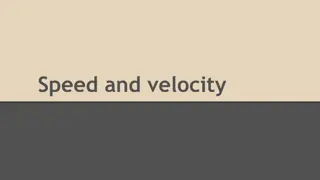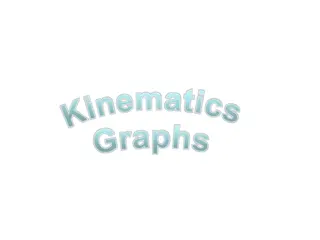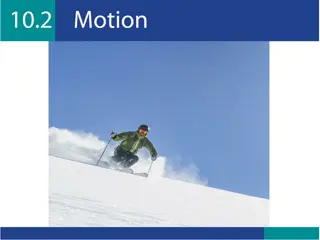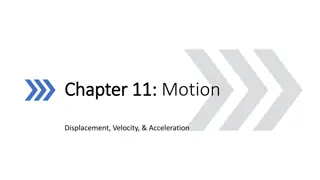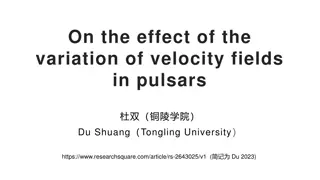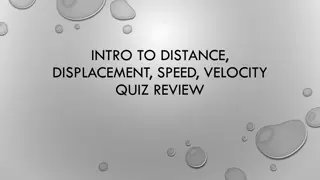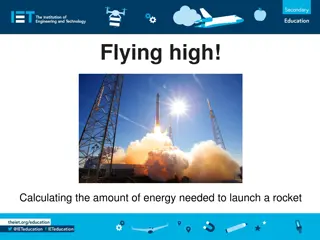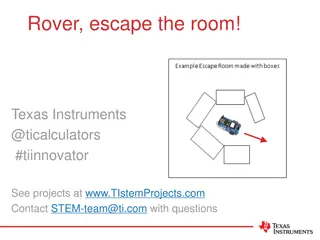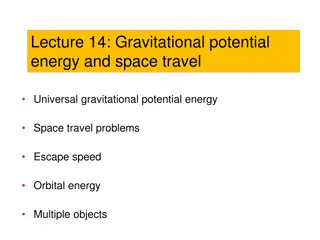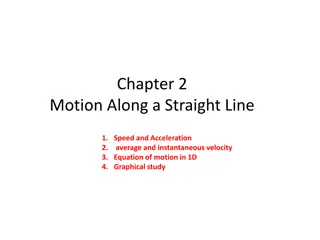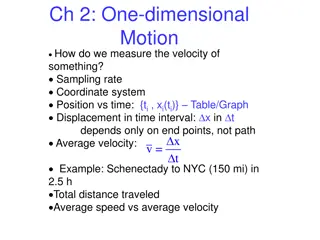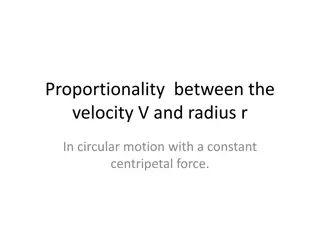Balloon Rockets
Have fun measuring balloon rocket velocity with a simple project! Follow the steps to set up your experiment safely. Determine velocity by timing balloon travel distance. Perfect for learning about physics.
0 views • 11 slides
Understanding Slider Crank Mechanism: Practice Problems and Solutions
Explore a practice problem based on a slider crank mechanism, involving calculations for velocity of the slider, velocity of a point on the connecting rod, and angular velocity. Detailed steps and solutions provided to understand the concepts clearly.
1 views • 6 slides
Kinematics of Machines: Instantaneous Center Method for Velocity and Acceleration Analysis
Explore the method of locating instantaneous centers in mechanisms to analyze velocity and acceleration. The content covers examples of pin-jointed four-bar mechanisms and slider-crank mechanisms, providing dimensions and angular velocities calculations. Prof. Divyesh B. Patel from L.E. College, Mor
0 views • 13 slides
Understanding Acceleration in Physics
Acceleration is the rate at which velocity changes, encompassing both increases and decreases in speed. In physics, acceleration is defined as the rate of change in velocity, making it a vector quantity due to its directional nature. This article explores the concept of acceleration, including examp
1 views • 15 slides
Understanding Velocity vs. Speed in Physics
Velocity and speed are fundamental concepts in physics that describe how fast an object is moving and in what direction. While speed is a scalar quantity representing the rate of motion, velocity is a vector quantity that includes both speed and direction. Constant velocity implies steady speed and
0 views • 8 slides
Understanding Kinetic Energy Equations and Examples
Learn how to rearrange and calculate kinetic energy using the formula KE = 1/2mv^2. Explore the definition, formula representation, solving for mass and velocity, related equations, and practice with calculation examples. Understand how mass and velocity affect kinetic energy in various scenarios.
0 views • 11 slides
IGCSE Physics Practice Questions: Forces and Motion, Radioactivity, Terminal Velocity
Practice answering IGCSE Physics longer answer questions on topics like forces and motion, radioactivity, and terminal velocity. Develop your understanding by reviewing model answers and marking points. Enhance your exam skills and knowledge with detailed explanations and examples.
0 views • 8 slides
Understanding Rotational Motion: Angular Velocity and Acceleration
Explore the concepts of angular velocity, radians, and rotational motion in this educational content. Learn about the relationship between angular and linear velocity, angular acceleration, tangential acceleration, and centripetal acceleration through practical examples. Enhance your understanding o
4 views • 17 slides
Flow Measurement Using V-Notch and Weirs in Engineering
Flow measurement in engineering involves the use of V-notch and weirs, such as rectangular weirs and triangular weirs, to calculate discharge rates and velocity of liquids. A V-notch is a triangular obstruction used for flow measurement, while weirs are larger scale structures for measuring river or
1 views • 7 slides
Determining Ultrasonic Wave Velocity in Liquid Using Interferometer
An ultrasonic interferometer apparatus is used to determine the velocity of ultrasonic waves in a liquid medium by creating longitudinal stationary waves and utilizing the principles of diffraction. The experiment involves passing monochromatic light through the liquid, creating an acoustic grating,
0 views • 16 slides
Understanding the Relationship Between Position, Velocity, and Acceleration Graphs
Gain intuition on how position, velocity, and acceleration are visually related through s-t, v-t, and a-t graphs. Discover how to interpret and draw accurate velocity vs. time plots based on position vs. time data. Learn the significance of comparing these charts and how they can be useful in variou
0 views • 20 slides
Understanding Velocity: The Key to Motion
Velocity is the speed and direction at which an object moves, indicating both its position and rapidity. It is crucial for measuring the rate of change of an object's position over time and differentiates from speed as a vector quantity. This comprehensive guide delves into the concepts of velocity,
2 views • 33 slides
Understanding Relative Velocity and Acceleration in Physics
Relative velocity is defined as the velocity of an object in the rest frame of another object, and it can be negative depending on the difference in velocities. The need for using relative velocity lies in determining if an object is at rest or moving. The formula for relative velocity involves the
1 views • 25 slides
Understanding Vectors and Velocity in Physics and Game Programming
Exploring the concepts of vectors, velocity, and positional vectors in both physics and game programming. Learn about key properties, conversion formulas, and the application of velocity vectors to positional vectors using examples and visual representations.
2 views • 32 slides
Physics Concepts: Angular Velocity, Radians, and Acceleration Explained
Understand essential physics concepts such as angular velocity in radians, comparison of angular velocities, tangential velocity, magnitudes of velocities, and angular acceleration as applied to various scenarios like rotating wheels, clock hands, and spinning objects. Dive into the relationships be
1 views • 31 slides
Escape the 9-to-5 Corporate Rat Race Coaching
Ready to escape the 9-to-5 grind? John Spencer Ellis offers a practical escape plan to help you transition from a monotonous job to a fulfilling career. His approach includes defining your vision, creating a strategic plan, optimizing finances, build
1 views • 1 slides
Understanding Relative Velocity of Bodies in Motion
The content explains concepts related to relative velocity of moving bodies, including diagrams illustrating velocity relationships, application of laws of parallelogram and triangle, analysis of motion in rigid links, and calculation of rubbing velocity at pin joints in mechanisms. It covers scenar
0 views • 23 slides
Graphical Method for Velocity Analysis of Planar Mechanisms
Learn about the graphical method for velocity analysis of planar mechanisms through practice problems involving slider-crank mechanisms and link velocities. Understand how to calculate slider velocity, point velocity, and angular velocities using the given dimensions and rotational speeds. Visualize
0 views • 6 slides
Measurement of Flow Velocity on Frozen and Non-Frozen Slopes of Black Soil Using Leading Edge Method
This study presented a detailed methodology for measuring flow velocity on frozen and non-frozen slopes of black soil, focusing on the Leading Edge method. The significance of shallow water flow velocity in soil erosion processes was emphasized. Various methods for measuring flow velocity were compa
0 views • 23 slides
Strategies for Generating Velocity Solutions with GLOBK
Basics of velocity solutions, setup strategies, and data cleaning methods for optimizing GLOBK solutions to generate position, velocity, offset, and postseismic parameter estimates. The aim is to combine years of data, make critical decisions on data treatment, and ensure accuracy in the process noi
0 views • 22 slides
Understanding Internal Flow in Heat Transfer Processes
Exploring internal flow characteristics in heat transfer, we delve into topics like laminar flow, velocity profiles, Reynolds number, and entry lengths for different flow regimes. Images illustrate concepts such as fully developed velocity profiles and the impact of flow conditions on the mean veloc
0 views • 27 slides
Understanding Acceleration in Physics
Explore the concept of acceleration through real-world scenarios involving moving objects and graphs. Learn how to determine the direction of acceleration based on the velocity changes of cars, divers, bungee jumpers, and more. Delve into examples of calculating average acceleration and final veloci
0 views • 11 slides
Understanding Motion: Speed, Velocity, and Acceleration
Motion is the change in position of an object relative to a reference point. Speed is the distance traveled divided by the time interval, while velocity includes direction. Acceleration refers to the rate of change of velocity. Different concepts and scenarios related to motion, speed, velocity, and
0 views • 16 slides
Understanding Speed and Velocity in Physics
Speed and velocity are fundamental concepts in physics. Speed is a scalar quantity that can be average or instantaneous, while velocity is a vector quantity that includes direction. Equations such as v=d/t help calculate these values. Average speed and average velocity are important in determining t
1 views • 10 slides
Understanding Kinematics Graphs in Physics
Explore the concepts of kinematics graphs through diagrams and descriptions. Learn to interpret distance-time, velocity-time, and speed-time graphs. Understand key parameters such as displacement, initial velocity, final velocity, constant acceleration, and time spent on different parts of a journey
0 views • 33 slides
Understanding Motion in Physics
Explore the concepts of speed, velocity, and acceleration in physics, learn how to interpret distance-time and velocity-time graphs, and practice calculating the speed and acceleration of objects. Engage in experiments to calculate average speeds and write reports detailing procedures, variables, da
0 views • 77 slides
Understanding Motion: Displacement, Velocity, and Acceleration
Explore the fundamental concepts of motion, including displacement, velocity, and acceleration. Learn about reference points, distance versus displacement, speed versus velocity, and how to calculate average speed and acceleration. Dive into examples illustrating these concepts in real-world scenari
0 views • 24 slides
Analyzing Firing Velocity of N-Strike Elite Nerf Gun by Haley Vermette
Haley Vermette conducted a project to test the claim made by Hasbro about the N-Strike Elite Nerf Gun's shooting range. Through critical thinking, problem-solving, and testing, various variables like time, distance, muzzle height, and firing velocity were analyzed to support or disprove the claim on
0 views • 15 slides
Impact of Velocity Field Variations on Pulsar Magnetic Fields
The study explores how variations in velocity fields affect pulsar magnetic fields, highlighting the conversion of kinetic energy to magnetic energy in pulsars. Glitches in these systems can lead to changes in magnetic fields, influencing pulsar emissions. The maintenance of stable magnetic fields a
0 views • 14 slides
Impact of M Dwarf Stellar Wind on Atmospheric Escape of a Mars-like Exoplanet
The study explores how the stellar wind from M dwarf stars affects the atmospheric escape of a Mars-like planet, focusing on the potential habitability of such exoplanets. Computer simulations utilizing stellar wind parameters provide insights into ion escape and the varying conditions at different
0 views • 19 slides
Motion and Velocity Concepts Illustrated Quiz Review
Explore concepts of distance, speed, displacement, and velocity through examples of a moving truck's position, Julie's journey to meet her friends, and calculations of velocity for trips from Pittsburgh to Philadelphia and Hong Kong to Los Angeles. Understand the differences between speed and veloci
0 views • 8 slides
The Fascinating World of Rockets: Energy, Escape Velocity, and More
Explore the intriguing realm of rockets, from the energy required for launch to the concept of escape velocity. Delve into the calculations behind rocket mass and the incredible feats achieved in space exploration. Unveil the formulas and historical context that shape our understanding of space trav
0 views • 8 slides
WP3 ESCAPE Summer School Funded by the European Union's Horizon 2020
WP3 ESCAPE Summer School, funded by the European Union's Horizon 2020, is a research and innovation initiative under Grant Agreement No. 824064. The program involves various working groups such as communication, scientific program, tutors organization, and educational platform. Communication platfor
0 views • 6 slides
Rover's Escape: Programming Challenges with Texas Instruments Calculators
Embark on a coding adventure with Rover and Texas Instruments calculators to solve puzzles and help Rover escape through challenging scenarios. Explore the world of STEM, problem-solving, and programming while guiding Rover through obstacles and utilizing the Ranger feature. Develop your programming
0 views • 15 slides
Effective Utilization of Escape Reports
Explore the comprehensive training overview covering various aspects, from running reports in Escape to customizing and exporting data. Learn to effectively use grids, track requisitions, and delve into vendor payment lookup. Dive into understanding IFAS vs. Escape report equivalents and master the
0 views • 22 slides
Battery Escape Room: Interactive Science Learning Experience
Engage students in a hands-on learning experience with the Battery Escape Room project funded by the EU's Horizon 2020 programme. In this innovative classroom activity, students are challenged to build batteries using everyday materials, explore electrochemistry concepts, and collaborate to solve pu
0 views • 4 slides
Understanding Gravitational Potential Energy and Space Travel
Explore the concepts of gravitational potential energy, orbital energy, escape speed, and satellite motion in the context of space travel. Learn about critical escape conditions, escape speeds from Earth and orbit, and the speed of satellites in circular orbits. Delve into multiple objects in space
0 views • 14 slides
Understanding Motion Along a Straight Line
Exploring the concepts of speed, acceleration, velocity, displacement, and distance in one-dimensional motion. Topics include average and instantaneous velocity, equation of motion, graphical analysis, position measurement, and the differences between distance and displacement. Dive into average spe
0 views • 47 slides
Understanding One-Dimensional Motion and Velocity Measurements
Exploring the concept of velocity measurement in one-dimensional motion, this content delves into the sampling rate, coordinate systems, and the relationship between position and time. It discusses average velocity, instantaneous velocity, and the significance of slope on graphs representing motion.
0 views • 22 slides
Understanding Orbital Motion and Circular Velocity in Physics
Explore the concept of orbital motion and circular velocity in physics, where we delve into the relationship between velocity and radius in circular motion with a constant centripetal force. Through Newton's 2nd Law and gravitational forces, we uncover the dependence of satellite speed on the radius
0 views • 13 slides
